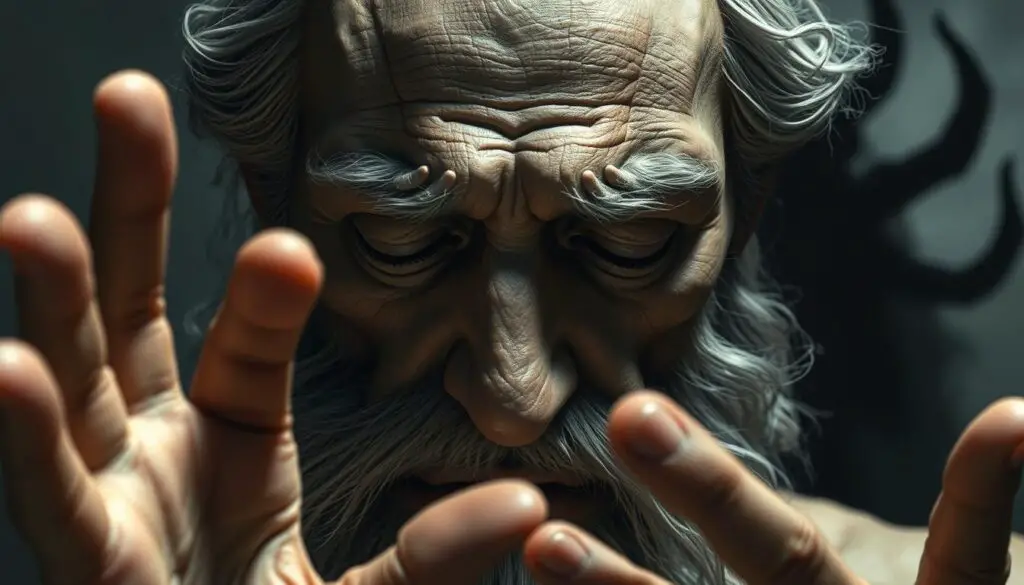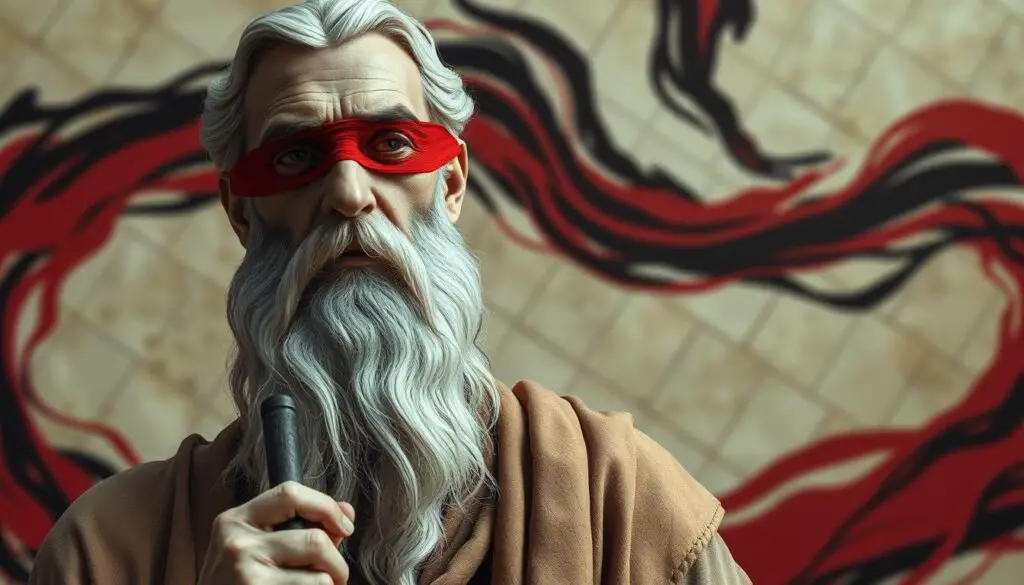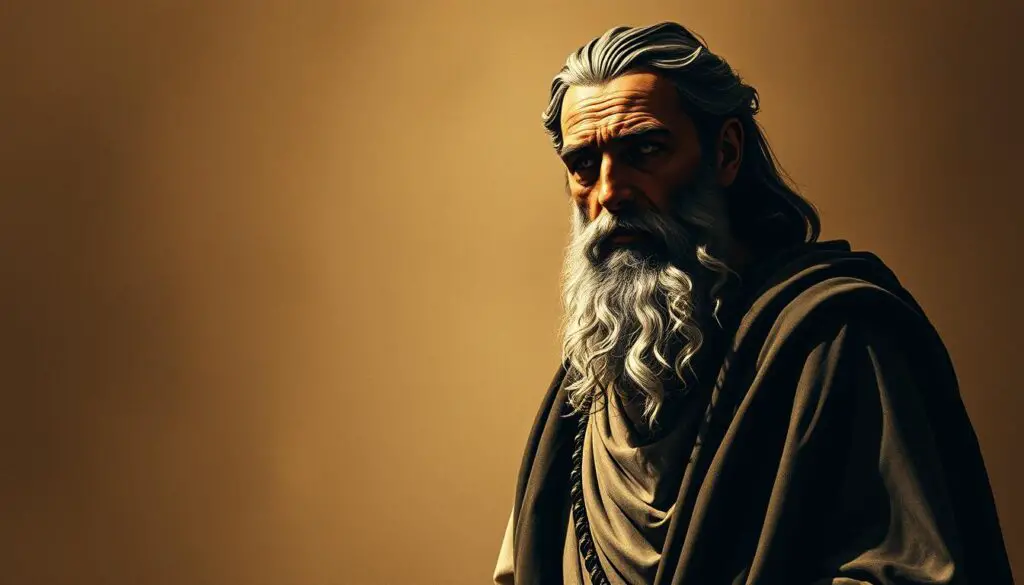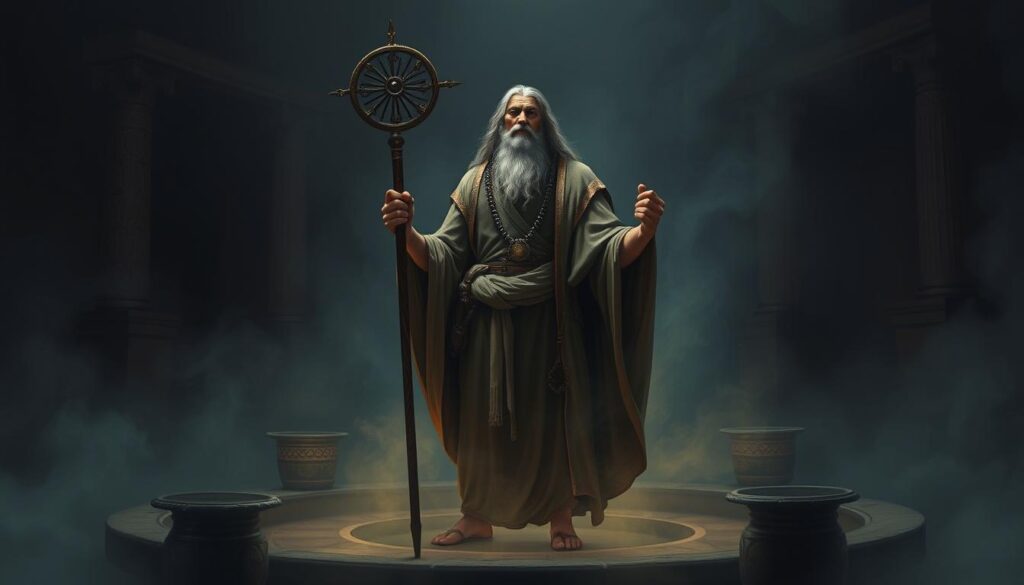One of the most enigmatic figures in Greek mythology, Tiresias, is renowned as the blind prophet whose life and visions were deeply interwoven with the fates of Thebes and its legendary heroes.
This Theban seer, famous for his gift of clairvoyance, had a unique narrative marked by extraordinary events, including a gender transformation that stands out in mythological tales.
Born to the shepherd Everes and the nymph Chariclo, Tiresias’ story is a tapestry of mystical encounters and divine interventions.
He wandered through the heart of Greek myths, offering insights and prophecies that shaped the destinies of many, from Oedipus to Odysseus.
Tiresias’ life was profoundly influenced by gods who bestowed upon him the unparalleled ability to understand the language of birds and divine the future from fire and smoke.
Throughout various tragedies and epic tales, the blind prophet’s presence was pivotal.
Whether it was advising Cadmus on founding Thebes or revealing the harrowing truths to Oedipus, Tiresias’ prophecies were unfailingly accurate.
Even after death, his clairvoyant powers persisted, as depicted in Homer’s “Odyssey.”
Key Takeaways
- Tiresias is a central figure in Greek mythology known for his clairvoyance and blindness.
- His story includes a unique episode where he was transformed into a woman for seven years.
- He advised famous mythological figures such as Oedipus and Odysseus.
- Tiresias’ prophecies were always true and influenced many major mythological events.
- His legacy continues to be referenced in modern literature and psychoanalysis.
Introduction to Tiresias
In Greek mythology, who was Tiresias? The famed oracle of Thebes is a name that frequently arises when discussing prominent figures of ancient lore.
Renowned as a peculiar combination of blind seer, clairvoyant, and possessing rare gender fluidity, Tiresias’s story captivates with its rich tapestry of divine encounters and human experiences.
Intriguingly, he was a pivotal Theban seer who served as an adviser for seven generations, guiding the city’s destinies and its rulers.
Tiresias’s journey is breathtakingly unique. Legend says that he was transformed into a woman for seven years after offending Hera by striking a pair of mating snakes.
This sex-change episode, initially a myth, expanded into seven elaborate segments during Hellenistic and Roman times, possibly penned by Ptolemaeus Chennus.
His metamorphosis reveals ancient perceptions of gender and the fluidity of identity.
After regaining his masculinity, Tiresias endured further trials, including being struck blind by Hera and receiving the gift of foresight from Zeus as compensation.
His visions were cryptic yet invariably accurate, with his counsel sought by legendary figures like Oedipus and Odysseus.
As a mediator between mortals and the divine, he holds a mirror to the power and fragility of human destiny.
The question of who was Tiresias extends beyond his roles in specific myths.
As the quintessential Theban seer, he not only foretold events but also bridged experiences of blindness and sight, life and death, male and female.
Such dualities make Tiresias an enduring symbol in literature, akin to the oracles who straddled the boundaries between the known and the unknown realms.
Through all his transformations and trials, Tiresias embodies the rich complexity of ancient Greek mythology, ever fascinating and ever relevant.
Early Life and Parentage

Tiresias’ origin is deeply rooted in Greek mythology, blending both mortal and ethereal elements.
His parentage sets the stage for the fascinating events of his life, marked by divine encounters and extraordinary transformations.
The Shepherd Everes
Tiresias was born to the shepherd Everes, a Theban speculated to be descended from the Spartoi, the warriors who sprang from the earth under the command of Cadmus.
This mortal lineage linked Tiresias to the noble and pastoral life of Thebes, grounding his extraordinary abilities in a distinctly human origin.
The Nymph Chariclo
Chariclo, a devoted nymph of Athena, was Tiresias’ mother. Her ethereal nature introduced celestial qualities into Tiresias’ being, making him an exceptional figure in Greek mythology.
The presence of the nymph Chariclo as his mother not only highlighted his dual nature but also established a close connection with the divine, particularly with the goddess Athena.
The Transformation of Tiresias

The transformation of Tiresias stands out as one of the fascinating tales in Greek mythology. Originating from an unexpected gender transformation, Tiresias’ life changed forever after an encounter with mating snakes.
This incident of Tiresias’ transformation began when he struck a pair of mating snakes, an act that led Hera to change his gender as punishment.
The Encounter with the Mating Snakes
Walking through the forest, Tiresias stumbled upon two mating snakes.
Striking them with his staff, he was suddenly transformed into a woman by Hera.
This transformation was a pivotal moment that would shape the rest of Tiresias’ life.
Life as a Woman
During the years as a woman, Tiresias embraced his new identity.
Living this new life for seven years, Tiresias became a priestess of Hera, got married, and even had children, including the renowned soothsayer Manto.
This period of his life added depth and dimension to the complexities of gender transformation within ancient Greek mythology.
Return to Manhood
After seven years, another encounter with the mating snakes reversed the transformation, turning Tiresias back into a man.
This final transformation solidified Tiresias’ unique position in Greek mythology, as one who has lived as both male and female.
His experiences enriched his role as a mediator and prophet, imparting wisdom that spanned diverse aspects of life and humanity.
These stories of transformation, including those found in Ovid’s Metamorphoses, where Tiresias’ gift of seeing the future is shared, highlight the profound impact of his dual-gender experience.
This intricate character not only influences Theban lore but also appears in various Greek tragedies, making him a timeless figure within the mythological tapestry.
The Blinding of Tiresias

The story behind Tiresias’ blindness is steeped in multiple myths within Greek mythology.
One prominent tale tells of a divine dispute between Zeus and Hera. When Tiresias, the blind prophet, sided with Zeus, Hera responded by taking away his sight.
This act of vengeance, however, was not without compensation from the gods.
In another account, Tiresias’ blindness is attributed to a chance incident where he stumbled upon Athena while she was bathing. Angered by this invasion of privacy, Athena struck Tiresias blind.
Yet, as a testament to his importance, she offered him a compensatory gift: the ability to understand birdsong, which allowed him to predict the future.
Thus, Tiresias’ blindness was paradoxically the gateway to an extraordinary clairvoyance, transforming him into a revered figure within Greek mythology.
It’s noteworthy that Tiresias experienced life as both a man and a woman, amplifying his unique perspective. He was turned into a woman by Hera as a punishment for killing two mating snakes and served as a priestess for Hera over seven years.
This transformation was another defining episode that shaped his wisdom and understanding of human nature.
Ultimately, the blind prophet’s interactions with gods and humans alike solidified his place in mythological lore.
Whether warning Amphitryon about Alcmene’s impending motherhood of twins or advising kings of Thebes, Tiresias’ blindness was not merely a loss—it was a profound transformation that defined his enduring legacy in Greek mythology.
The Gift of Prophecy
Theban seer Tiresias is renowned throughout Greek mythology for his extraordinary prophetic abilities.
This gift of prophecy was not solely intuitive but involved various divination methods, including interpreting birdsong and examining smoke and entrails from sacrifices.
One of the primary sources of his insight came from communicating with the dead, a method that allowed him to provide guidance on numerous significant occasions.
The Methods of Divination
To deliver Tiresias’ prophecy, the seer employed several methods to gain knowledge.
He frequently relied on augury, the practice of interpreting the cries and movements of birds, a skill that was reportedly bestowed upon him by Athena.
Additionally, Tiresias would analyze signs in fire or smoke, making it possible for him to foresee events with great accuracy. This range of divination methods contributed to his unwavering reputation as a trusted oracle throughout Thebes.
The Granting of Clairvoyance by Zeus
According to legend, Tiresias was struck blind by Hera as punishment for claiming that women experienced more pleasure in sexual relations than men.
To compensate for this harsh sentence, Zeus granted Tiresias the gift of foresight. This act of granting clairvoyance by Zeus not only restored balance but also enhanced Tiresias’ role in the mythic narrative.
In addition to this gift, he was blessed with an extended lifespan, allowing him to witness and influence pivotal moments in Greek mythology.
Tiresias in Theban Lore

Tiresias stands out as a pivotal figure in Theban mythology, whose far-reaching influence spans numerous generational narratives.
His significant contributions ranged from counseling kings like Laius and Oedipus to advising warriors during the Seven Against Thebes campaign.
As an esteemed prophet, Tiresias’ unique insights substantially impacted the fate of Thebes and its inhabitants.
Tiresias’ prophecies were indispensable during critical moments in Thebes’ history.
For instance, during the second Theban war, he recommended sending a herald to negotiate with the Argives.
In another notable instance, Tiresias advised the Thebans to sacrifice Menoeceus to Ares to secure victory against their foes.
This demonstrates his vital role in shaping military strategies and decisions within Greek lore.
Moreover, Tiresias’ influence extended beyond his lifetime. Even after his death, he played a crucial role in mythological tales, such as advising Odysseus in the Underworld regarding his return to Ithaca.
This highlights Tiresias’ everlasting importance in Greek mythology.
His family, too, had significant roles within Theban mythology. His daughter, Daphne, was captured by the Epigoni after their victory and dedicated to the sanctuary at Delphi.
She was believed to have inherited a prophetic ability even greater than her father’s, continuing Tiresias’ legacy.
Throughout Tiresias’ exceptionally long life, reputed to span seven generations, his involvement in Theban lore remains unparalleled.
His journey from a mortal to a revered seer, paired with his experiences as both man and woman, offers a captivating narrative in Greek lore.
This multifaceted character continues to be an essential point of reference in the sagas of Thebes.
Advising Oedipus in Oedipus Rex

In the riveting Greek tragedy “Oedipus Rex” by Sophocles, the blind prophet Tiresias provides pivotal insights that shape the story’s outcome.
Oedipus, the determined and shrewd king of Thebes, seeks Tiresias’ advice to unveil the cause of the suffering brought by the Theban plague.
The Plague of Thebes
At the play’s onset, a severe plague devastates Thebes, leading its people to implore their king for a solution.
The priest’s conversation with Oedipus from lines 1-85 reveals the city’s dire situation, underscoring the urgency for Oedipus to act.
Oedipus, driven by his hubris and determination, summons Tiresias, trusting in the prophet’s visions to cure the Theban plague.
Revelation of Oedipus’ Fate
Tiresias eventually appears from lines 276-379, initially reluctant to disclose the tragic truth he perceives.
Pressed by Oedipus, he unveils that Oedipus himself is the source of Thebes’ misfortune, having unknowingly killed his father and married his mother.
The confrontation between Oedipus and Tiresias from lines 380-461 is intense, with accusations of conspiracy that mark a turning point in the plot.
It becomes evident that Tiresias’ advice, while painful, is a cornerstone of the Greek tragedy’s narrative, driving the revelation of Oedipus’ identity.
As the story progresses, the true dimension of Oedipus’ fate unfolds from lines 975-1076, exposing the inescapable nature of the prophecy.
The climactic scenes between lines 1423-1475, where Oedipus blinds himself and grieves for his daughters, epitomize the tragic conclusion typical of a Greek tragedy.
Oedipus’ journey is a poignant reminder of how noble qualities and tragic flaws intertwine, compelling both characters and readers to confront the inexorable power of fate.
The Role of Tiresias in Antigone

In Sophocles’ Antigone, Tiresias is once again prominent as Thebes’ most respected seer, playing a pivotal role in the dramatic unfolding of events.
King Creon is staunch in his refusal to bury Polynices, defying the divine laws, which sets the stage for Tiresias’ crucial intervention.
Tiresias steps in to warn Creon about the dire consequences of his actions. His prophecies in this ‘Greek drama’ serve as a ‘divine warning’ that should not be ignored.
Tiresias advises Creon that the city of Thebes suffers because of his decision.
This perilous defiance of divine law positions ‘Tiresias’ as a mediator between the gods and humans, emphasizing the conflict between human legislation and divine will.
Prominently, ‘Tiresias’ foretells that the gods will exact their revenge for Antigone’s unjust death by taking the life of Creon’s child.
This prophecy is a turning point in the drama, adding weight to Tiresias’ grave words. He sternly cautions Creon, underscoring that inflexible adherence to ill-fated decrees will only bring ruin.
Tiresias is described in the play as irascible and blunt, not mincing his words as he delivers his chilling prophecies.
This unvarnished truth often leads characters like Oedipus and Creon to initially reject his wisdom—a common reaction depicted in ‘Greek drama’.
When Tiresias warns Creon about the consequences of his actions, he is met with skepticism and resistance, mirroring the reactions in Oedipus Rex.
Ultimately, Creon’s dismissal of Tiresias’ prophecy turns tragic as events unfold, forcing Creon to recognize his errors too late.
This instant marks the downfall of Creon and his family members, serving as a powerful cautionary tale of the consequences of disregarding prophetic insight.
The clash of human pride against divine ordinance is highlighted through ‘Tiresias” essential role in both Antigone and Oedipus Rex, showcasing a seamless continuity in his character’s integral part in the ‘Greek drama’.
Who was Tiresias: His Legacy and Symbolism
The Legacy of Tiresias extends far beyond his renowned role in Greek mythology as the blind prophet.
His inherent wisdom and unique insights have solidified his place in stories and traditions, particularly in his association with characters like Oedipus and Odysseus.
However, understanding what his blindness represents and how it intersects with his gift of prophecy requires a deeper look.
The Blind Prophet
Tiresias is best known as the blind prophet, a figure whose lack of physical sight is compensated by extraordinary clairvoyance.
The blindness of Tiresias is not just a literal impairment but serves as a powerful symbol in Greek mythology.
It reinforces the motif that true wisdom and divine insight come not from physical vision but from a deeper, more profound internal awareness.
Indeed, Tiresias’ ability to diagnose and predict divine interventions signals his readiness to understand and convey the will of the gods, despite the absence of physical sight.
The Symbol of Wisdom
In Greek mythology, Tiresias stands out as a paragon of wisdom and moral integrity.
He is often depicted as a wise old prophet, particularly in Sophocles’ “Oedipus Rex,” where he serves as the agent of knowledge and truth.
His prophecy plays a crucial role in unraveling the mysteries of the plot, impacting Oedipus profoundly.
Tiresias embodies a kind of wisdom that transcends ordinary human faculties, reflecting the larger forces of Apollo and Fate.
His legacy as the blind prophet showcases the powerful symbolism of wisdom in Greek mythology, reminding us that true insight often requires looking beyond the physical realm.
Tiresias in the Odyssey
Within Homer’s Odyssey, the figure of Tiresias holds a distinct place as the blind prophet whose insights are crucial to the narrative. Tiresias in the Odyssey is not just a mere character but a pivotal element guiding Odysseus during his arduous journey to the underworld.
Odysseus’ Journey to the Underworld
Odysseus’ underworld journey is one of the defining moments in Greek epic poetry.
Tasked with consulting the spirit of Tiresias, Odysseus embarks on a perilous path to Hades.
This journey underscores Odysseus’ desperation and hope, seeking wisdom to navigate the challenges that lie ahead.
Tiresias, the only seer to maintain his prophetic abilities even in death, emerges as an essential voice guiding the hero.
The Prophecies of Tiresias
Tiresias’ advice to Odysseus during this encounter is invaluable.
Foreseeing the obstacles that Odysseus will face, such as the dangers posed by Scylla and Charybdis, Tiresias provides clear instructions on how to overcome these perils.
His prophecies are not merely warnings but also revelations that steer Odysseus toward his ultimate goal of returning home.
Tiresias’ role thus solidifies his stature within the realm of Greek epic poetry, illustrating his enduring impact on the narrative and characters of the Odyssey.
The Death of Tiresias
The story of Tiresias’ death, much like his life, is shrouded in ambiguity.
According to some accounts within Theban mythology, the Greek seer’s end came after he drank from the tainted spring of Tilphussa.
This spring, located near Haliartus in Boeotia, played a pivotal role in this tragic conclusion.
Other narratives propose that Tiresias’ death was a result of divine intervention, highlighting the complex relationships between mortals and gods in Greek mythology.
Even after Tiresias’ death (impaled by an arrow of Apollo and drinking tainted water), the seer retained his clairvoyant abilities in the afterlife.
His shade descended to the Asphodel Meadows in Hades, where he continued to prophesy.
Notably, he provided invaluable guidance to Odysseus during the hero’s journey to the underworld.
This undying clairvoyance further cements Tiresias’ prestigious position in Theban mythology.
His immortality, in a sense, surpasses that of mere physical existence, as his prophetic wisdom and insight endured even after the Greek seer’s end.
The legacy of Tiresias’ death thus remains an integral narrative thread in the tapestry of Greek myths.
Tiresias in Roman Literature
In the realm of Roman mythology, Tiresias is a fascinating figure who bridges the gap between Greek and Roman cultural narratives.
Unlike many Greek characters who are often given Latinized names in Roman adaptations, Tiresias retains his original name, highlighting his unique standing in both mythological traditions.
His story, which traverses themes of transformation, prophecy, and divine intervention, is told with slight variations, creating a rich tapestry that underscores the profound Greek-Roman connections.
Tiresias’ role in Roman literature is emblematic of the broader process of mythological adaptation that characterized the relationship between Greek and Roman cultures.
For instance, in Roman retellings, his transformation into a woman for seven years features prominently.
This experience, unique to Tiresias, allowed him to offer unparalleled insights into human nature, a trait highly valued in both Greek and Roman contexts.
His longevity and wisdom also make significant appearances in works that straddle these cultural lines.
Living to the age of 175, Tiresias witnessed and participated in numerous historical and mythological events from Thebes to Delphi. Roman authors, inspired by his multifaceted experiences, often portrayed him advising Theban leaders, echoing his roles in Greek tragedies such as Oedipus Rex and Antigone.
One of the most intriguing aspects of Tiresias in Roman literature is his enduring ability to prophesize.
Granted this gift by Zeus as compensation for his blindness, Tiresias’ powers of divination make him a sought-after seer, even beyond the Hellenistic territories.
This is especially evident in Roman texts where his prophetic abilities are invoked to lend deeper meaning and foresight, exemplifying the profound Greek-Roman connections in mythology.
In conclusion, Tiresias’ presence in Roman mythology illustrates the seamless fusion of Greek and Roman mythological traditions.
Through nuanced adaptations, his story continues to captivate, offering timeless reflections on human nature, transformation, and the divine.
Depictions in Art and Literature
The profound impact of Tiresias depictions throughout art and literature is evident in various cultural expressions.
Artists and authors have continuously drawn inspiration from his story, portraying him as a vessel of divine truth and human complexity.
Ancient Pottery
One of the earliest forms of Tiresias depictions can be found on ancient Greek pottery.
These visual interpretations often illustrate key scenes from his life, such as advising Oedipus or encountering the mating snakes.
Ancient Greek pottery not only captures his physical transformations but also emphasizes his significant role within Greek mythology as a unique figure who embodies both masculine and feminine qualities.
Modern Literary References
Tiresias’ complexity and wisdom have intrigued numerous literary figures across time.
In the modern literary works by Geoffrey Chaucer, Jonathan Swift, Alfred Tennyson, D.H. Lawrence, and W.B. Yeats, Tiresias appears either directly or through allusions.
These references explore the implications of his divine prophecies and unique experiences.
More recently, modern terms such as nonbinary, genderqueer, and genderfluid have been applied to Tiresias, reflecting renewed interpretations of his gender transformations.
Such diverse readings in contemporary literature highlight Tiresias depictions as transcending traditional gender constructs and symbolizing various polarities of human nature.
Overall, Tiresias remains a compelling figure within art and literature, his story continuously reimagined and reinterpreted through the ages.
Conclusion
The story of Tiresias, enriched with themes of transformation, wisdom, and prophecy, offers a timeless narrative that resonates through the ages.
As a crucial figure in Greek mythology, Tiresias’ life is marked by remarkable events, from his unique transformation into a woman to gaining the gift of prophecy after divine encounters.
His wisdom and foresight, encapsulated in prophecies and valuable advice, underscore his significance in myths such as “The Odyssey” and “Oedipus Rex,” where he played key roles in guiding heroes and shaping their fates.
Tiresias’ legacy continues to influence modern literature and culture. Poets like Tennyson and T.S. Eliot have drawn inspiration from his myth, highlighting the enduring relevance of this blind prophet’s influence.
His encounters with major figures of Theban lore, like Oedipus and Creon, illustrate the profound impact of his prophecies on human lives, reinforcing the moral and philosophical depths of Greek mythology.
This broad influence signifies Tiresias’ role in exploring human nature and the divine, prompting reflection on themes like fate, destiny, and the consequences of one’s actions.
Even today, the tale of Tiresias speaks volumes about the human condition, embodying a unique aspect of Greek mythology’s enduring legacy.
His story not only fascinates but educates, reflecting the complex interplay between divine authority and human agency.
To learn more about this fascinating character, check out this comprehensive analysis on the myth of Tiresia.
As we delve deeper into these ancient tales, it becomes clear that the blind prophet’s influence continues to captivate and inspire across generations, testament to the timeless nature of his story.
Frequently Asked Questions
Q: Why did Tiresias turn into a woman?
Tiresias was transformed into a woman after he intervened in a dispute between two snakes. According to legend, Hera and Zeus disagreed on who experienced more pleasure during intercourse, men or women. To resolve this, Zeus turned Tiresias into a woman for seven years to experience life from both perspectives.
Q: Why was Tiresias killed?
In mythology, Tiresias was not explicitly “killed” in the traditional sense; he died of old age. As a prophet, many of his narratives focus more on his prophetic insights and the consequences of his revelations rather than on his death.
Q: Why did Tiresias refuse to tell the truth?
Tiresias often found himself in precarious situations where telling the truth could lead to dire consequences. In some myths, his reluctance to disclose truths is linked to the potential repercussions from those who might be affected by his prophecies.
Q: What is the symbol of Tiresias?
Tiresias is commonly associated with the symbol of the staff or caduceus, which he uses to navigate as a blind prophet. This symbol represents his connection to the divine and his role as a seer.
Q: What is Tiresias’s special power?
Tiresias’s special power was prophecy. He possessed the ability to foretell the future and provide divine insights, a gift granted to him by the gods in compensation for his blindness.
Q: How are Persephone and Tiresias connected?
Persephone and Tiresias are connected through the underworld. According to mythology, Tiresias was able to retain his prophetic abilities even in the underworld because of Persephone’s favor, allowing him to continue his role as a seer among the dead.
Q: Who does Tiresias represent?
Tiresias represents wisdom and the complexity of truth. As a blind seer, he embodies the idea that insight and understanding can come from sources beyond normal perception.
Q: What might be symbolic of Teiresias being blind?
The blindness of Tiresias is symbolic of inner vision and insight. It suggests that true wisdom and prophetic abilities come not from physical sight but from spiritual and divine understanding.




